A look at the key findings and recommendations from the recent Serious Hazards of Transfusion (SHOT) annual report.
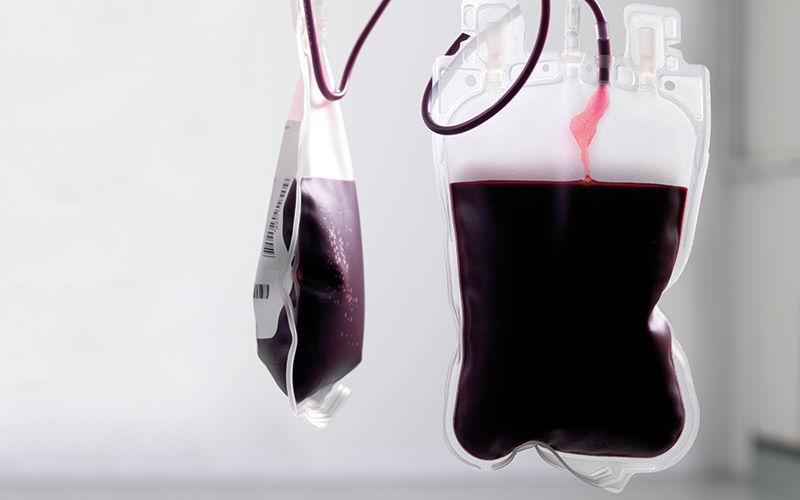
Blood transfusion is commonplace within clinical practice, with 2.2 million blood components issued in the UK in 2022. Although generally safe, preventable transfusion errors continue to be reported and actions are needed to improve transfusion safety and prevent patient harm. Since 1996, SHOT (the UK’s independent, professionally led haemovigilance scheme) has collected and analysed anonymised information reported in the UK on serious adverse reactions and events related to blood transfusion. SHOT provides annual recommendations that are circulated to all relevant organisations, and all hospitals reporting to SHOT. The 2022 Annual SHOT Report was published in July 2023 and is available at shotuk.org. SHOT produces participation data that provides a useful benchmarking tool and is an integral part of continuous improvement in healthcare.
It is reassuring to see a good reporting culture and reporting levels have increased, with 4371 reports submitted to SHOT in 2022. This is an increase of 283 (6.9%) from 2021 (see Figure 1).
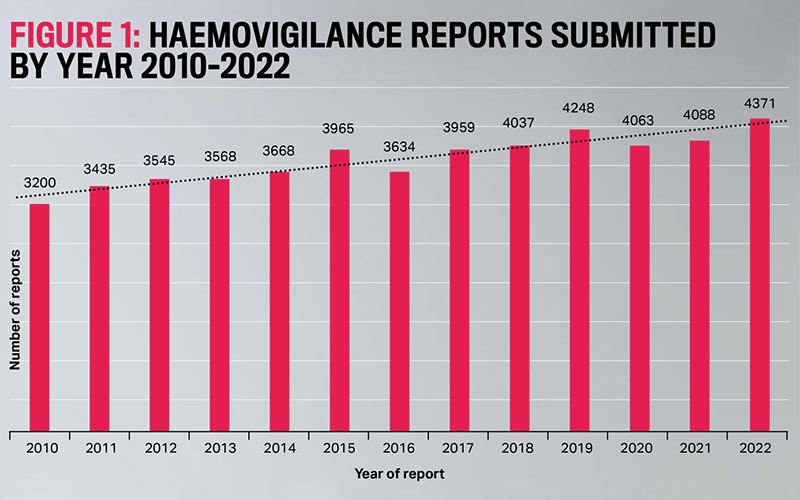
Of these, 3499 reports were analysed and included, which is an increase of 338 from 2021. The number of incidents reported from emergency departments have increased for the second year in a row and are now almost double the number reported in 2020, which may be due to increased workload and staffing pressures. This trend, however, was not observed in any other area.
ABO-incompatible (ABOi) transfusions
Prior to 2022, the last ABOi-related death in the UK occurred in 2015, and there were no reports of ABOi red cell transfusions in 2021. Unfortunately, in 2022 there were five ABOi red cell transfusions, two of which resulted in preventable patient deaths and one major morbidity (see Figure 2). There was also one ABOi plasma transfusion.
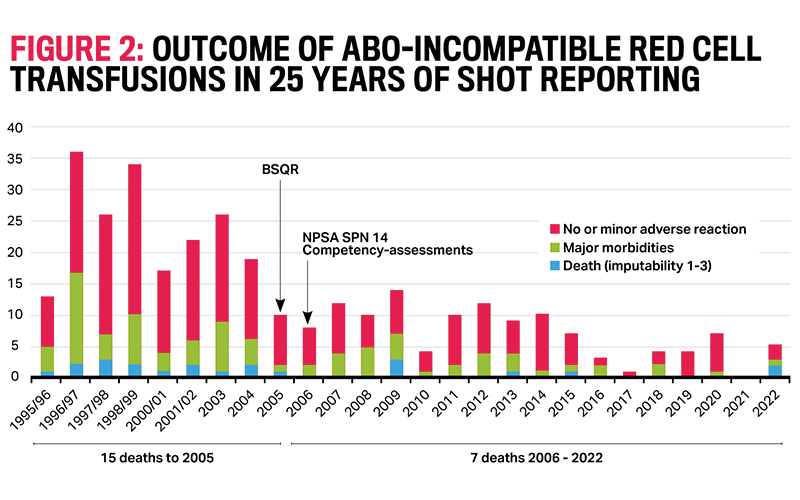
All red cell ABOi transfusions were due to clinical errors: two collection, two administration and one historical wrong blood in tube (WBIT) error. A component selection error in the transfusion laboratory resulted in an ABOi plasma transfusion. Patient identification errors were identified as the primary error in most of these cases. Other contributory factors included staff recruitment and retention issues, high workload, knowledge gaps, overreliance on IT, decision fatigue and assumption bias.
There were 890 reported near miss WBIT errors, with 689 reports providing an ABO group. Of these, 320 (46.4%) could have resulted in an incompatible transfusion (see Figure 3). Laboratory processes detected 717 of the 890 reported WBIT, highlighting the vital role that the transfusion laboratory plays in preventing patient harm.
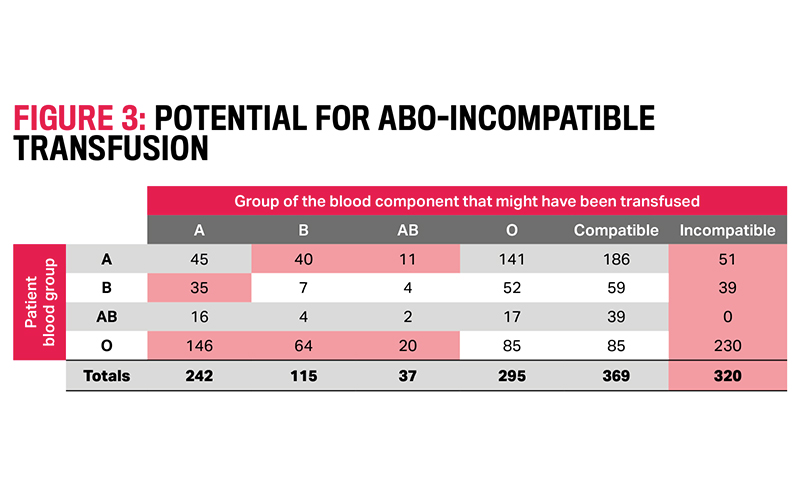
Laboratory key findings
In 2022, SHOT received reports of 431 laboratory errors and 220 laboratory near misses. This represents a 13.6% increase on 2021. Reports suggest that laboratories are experiencing staffing issues and training difficulties, and identified contributory factors are outlined in Figure 4.
The numbers of transfusion laboratory errors are represented in Figure 5. The highest number of incidents occurred during the testing stage followed by component labelling, availability and handling and storage errors (CL-A-HSE) and component selection.
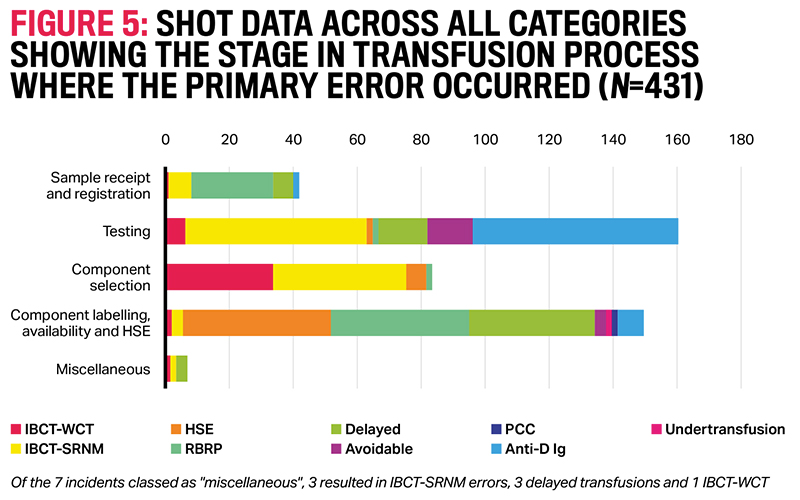
Case study
Incorrect ABO group issued via Electronic Issue in error for a liver transplant patient.
A group A male patient in his thirties underwent a liver transplant from a group O donor. The LIMS was not updated with the appropriate flag to reflect the transplant and the requirement of group O red cells and exclusion from electronic issue, with only a note of the liver transplant added to the notepad section. Six units of group A red cells were transfused during theatre, and five days post-transplant a further unit of group A red cells was released via remote issue. The investigation stated the standard operating procedure (SOP) was not clear on when the flag should be added.
- Laboratory SOP must have clear protocols for transfusion requirements for transplant patients
- Electronic issue (EI) rules should be in place to force serological crossmatch in this patient group
- Where possible, LIMS flags should be present for all transplant patients
- Interoperability of clinical and laboratory IT systems would increase safety for transplant patients.
Testing errors
Testing errors have increased by over 25% since 2021. They were mainly due to errors relating to anti-D immunoglobulin (Ig) (62/157) and incorrect blood component transfused – specific requirements not met (IBCT-SRNM) (56/157). They included cell-free fetal DNA discrepancies (predicted vs confirmed), procedural errors by laboratory staff, release of blood components prior to completion of testing and inappropriate electronic issue (EI).
Component labelling, availability and handling and storage (CL-A-HSE) errors
CL-A-HSE errors mainly consisted of cold chain errors (where blood components were incorrectly returned to stock following temperature excursions and refrigerator failures) and transposition of labels between blood components.
Component selection errors
Component selection errors were mainly related to units issued not meeting specific requirements (41/81; 50.6%) and wrong component issued (33/81; 40.7%), including not phenotyped/antigen-negative, not irradiated, and K-positive blood components to patients of childbearing potential. There were 28 components with incorrect ABO group issued, of which 13 were to haemopoietic stem cell transplant (HSCT) and solid organ transplant (SOT) patients. IT contributed to many component
selection errors, with either the laboratory information management system (LIMS) alerts being overridden or limitations within the LIMS rules not clearly stating the requirements for patients.
In 2023, the SHOT IT working group – SHOT UK Collaborative Reviewing and reforming IT Processes in Transfusion (SCRIPT) created a comprehensive document to support the implementation of safe IT systems within the hospital and transfusion laboratories, which can be found on the SHOT website or app (shotuk.org/resources/current-resources/script/).
Outcome of laboratory errors reported
There were no deaths associated with laboratory errors, however, there were four cases that resulted in major morbidity. All cases involved sensitisation to the K antigen in patients of childbearing potential due to incorrect component selected.
Case study
Good practice by laboratory staff triggers lifesaving treatment of baby
A biomedical scientist identified a mixed field (MF) result within a group and screen sample for a pregnant patient. This prompted them to contact the clinical area to request an additional sample and highlight the risk of large fetomaternal haemorrhage. The patient was brought back into hospital for cardiotocography. The results were suspicious and resulted in early delivery of the baby. The baby was anaemic and required red cell transfusion. Had this not been noted by the biomedical scientist and escalated, the mother may not have been reassessed and the baby not successfully delivered. A “Greatix” report was raised to acknowledge the prompt action of the biomedical scientist.
- Because the biomedical scientist had good underlying knowledge of the potential causes of MF reactions and appropriate clinical knowledge they were able to act promptly
- There will be increased knowledge of this potential complication within the networks where the information was shared, therefore there may be a ripple effect of more lives saved
- Sharing learning from excellence increases morale.
Near misses
Many errors continue to occur at component labelling due to transposition of labels between units intended for the same patient. These errors were detected by vigilant clinical teams, demonstrating how efficient collaborative teamwork is crucial to ensure patient safety. Following are the key messages and recommendations relating to the laboratory incidents analysed in The 2022 Annual SHOT Report:
Laboratory key messages
- Sensitisation to the K antigen in patients of childbearing potential is preventable in most circumstances
- A mismatch in workload and staffing levels had some impact upon over half of all laboratory incidents. When staffing levels are unsafe this must be escalated
- Electronic systems should act as an additional barrier. Having transfusion IT systems in place does not negate the need for staff knowledge and skills. Staff should not rely on IT as the only fail-safe mechanism
- Final checking of the unit prior to issue is essential. The use of label verification in LIMS or electronic blood-tracking systems helps to optimise safety.
Laboratory recommendations
- Many errors occur due to established procedures not being followed. It is important that laboratory staff understand the “why” of an action before they move onto the “how”. The UPTAKE model of competency assessment remains a useful model to base competency assessments upon
- Inadvertent sensitisation to the K antigen is classed by SHOT as causing major morbidity and can have devastating consequences in future pregnancies. Standard operating procedures surrounding provision of K-negative components when appropriate should be reviewed to identify any gaps
- Staff who are providing training within the laboratory should have the requisite knowledge before delivering this training, in line with UK Transfusion Laboratory Collaborative (UKTLC) standards to ensure knowledge gaps are not perpetuated.

Uptake model of competency-assessment (Narayan et al. 2020)
- Understands procedure being assessed
- Performs tasks accurately
- Takes heed of limits of procedure
- Applies knowledge and scientific background and rational for procedure
- Knows and considers risks of not following process
- Explains exceptions and where to find further advice if needed.
UK Transfusion Laboratory Collaborative
The UKTLC aims to influence positive changes within the transfusion community through the collaborative identification and promotion of best practice. It provides informed recommendations regarding staffing levels and competency within UK transfusion labs to promote staff and patient safety.
In 2022 a UKTLC survey was sent with the intention of representing a “snapshot” of working conditions within UK transfusion laboratories on a single day. The themes of the survey were:
- Staffing
- Qualifications, knowledge,and skills
- Information technology
- Just culture
Responses indicated an increase in workload and staff vacancies, leading to difficulties in recruitment and retention of staff and to additional training and supervisory burdens on remaining staff. Training has become more difficult and concerns have been raised about the level of education in newly qualified HCPC-registered biomedical scientists. Staff responsible for quality of work face challenges over protected time to complete tasks and transfusion laboratory managers are consistently required to cover bench work to meet service needs.
Despite SHOT and UKTLC recommendations for the implementation of electronic blood management systems for patient safety, approximately a third of responders had none in place and less than a quarter had full vein-to-vein systems. Learning from incidents was shared widely in many organisations, with over half saying there was also learning from excellence. All responders stated they had a documented system to raise concerns. Human factors principles were applied in >80% of laboratories across a wide range of day-to-day aspects. New UKTLC standards (2023) outline minimum standards for staff qualifications, training, competency, and the use of IT in hospital transfusion laboratories. An abridged version of the standards is available on the SHOT website for laboratories to begin the compliance and gap analysis process.
Case study
Incorrect ABO platelets issued following HSCT with contributory human factors
A group O D-positive male in his 30s received an A D-positive HSCT but was issued with group O platelets in error. There were LIMS alerts in place, but the reporter stated that there were limitations associated with management of platelets in transplant patients. The laboratory relied on biomedical scientist staff being familiar with these limitations when selecting appropriate platelets. Multitasking of multiple crossmatches and platelet requests and rushing to complete work prior to the end of their shift also contributed to this error. Workload management has been discussed with the transfusion laboratory team, and the limitations within the LIMS have been escalated on the local risk register.
- IT should not introduce additional complexity to a process
- Where safety-critical workarounds are required, all steps should be detailed within SOP and appropriate risks raised within quality management procedures
- Where work cannot be safely completed before the end of a shift, avoid starting the task where possible. If time pressures will not allow, a clear, documented handover should be used to reduce the risk of error.
Acknowledging continuing excellence
Whilst there are many challenges identified in the transfusion laboratory, data submitted to SHOT also identifies areas where laboratory staff are excelling. Studying excellence in healthcare, including in transfusion laboratories, can create new opportunities for learning, and help improve resilience and staff morale.
Conclusion
Transfusion laboratories are critical for providing safe and timely blood components and are a vital link in the transfusion care of patients. To ensure this service is delivered, laboratories must be sufficiently staffed, with trained and competent staff, with the right skill mix. It is essential that laboratories have adequate resources, including well-designed IT systems to support safe transfusions. Final checks of blood components prior to release for use in patients would identify and prevent many laboratory-based errors.
This article was a collaboration between the SHOT Team (Caryn Hughes, Nicola Swarbrick, Shruthi Narayan, Vera Rosa and Victoria Tuckley) and Anne Lockhart from the Scottish National Blood Transfusion Service.
Image credit | Getty




